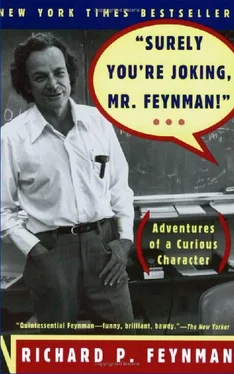The others kept talking about how good the oysters were, so I had another oyster, and that was really harder than the first one.
This time, which must have been my fourth or fifth time touring the Bell Labs, they accepted me. I was very happy. In those days it was hard to find a job where you could be with other scientists.
But then there was a big excitement at Princeton. General Trichel from the army came around and spoke to us: “We’ve got to have physicists! Physicists are very important to us in the army! We need three physicists!”
You have to understand that, in those days, people hardly knew what a physicist was. Einstein was known as a mathematician, for instance—so it was rare that anybody needed physicists. I thought, “This is my opportunity to make a contribution,” and I volunteered to work for the army.
I asked the Bell Labs if they would let me work for the army that summer, and they said they had war work, too, if that was what I wanted. But I was caught up in a patriotic fever and lost a good opportunity. It would have been much smarter to work in the Bell Labs. But one gets a little silly during those times.
I went to the Frankfort Arsenal, in Philadelphia, and worked on a dinosaur: a mechanical computer for directing artillery. When airplanes flew by the gunners would watch them in a telescope, and this mechanical computer, with gears and cams and so forth, would try to predict where the plane was going to be. It was a most beautifully designed and built machine, and one of the important ideas in it was non-circular gears—gears that weren’t circular, but would mesh anyway. Because of the changing radii of the gears, one shaft would turn as a function of the other. However, this machine was at the end of the line. Very soon afterwards, electronic computers came in.
After saying all this stuff about how physicists were so important to the army the first thing they had me doing was checking gear drawings to see if the numbers were right. This went on for quite a while. Then, gradually the guy in charge of the department began to see I was useful for other things, and as the summer went on, he would spend more time discussing things with me.
One mechanical engineer at Frankfort was always trying to design things and could never get everything right. One time he designed a box full of gears, one of which was a big, eight-inch-diameter gear wheel that had six spokes. The fella says excitedly “Well, boss, how is it? How is it?”
“Just fine!” the boss replies. “All you have to do is specify a shaft passer on each of the spokes, so the gear wheel can turn!” The guy had designed a shaft that went right between the spokes!
The boss went on to tell us that there was such a thing as a shaft passer (I thought he must have been joking). It was invented by the Germans during the war to keep the British minesweepers from catching the cables that held the German mines floating under water at a certain depth. With these shaft passers, the German cables could allow the British cables to pass through as if they were going through a revolving door. So it was possible to put shaft passers on all the spokes, but the boss didn’t mean that the machinists should go to all that trouble; the guy should instead just redesign it and put the shaft somewhere else.
Every once in a while the army sent down a lieutenant to check on how things were going. Our boss told us that since we were a civilian section, the lieutenant was higher in rank than any of us. “Don’t tell the lieutenant anything,” he said. “Once he begins to think he knows what we’re doing, he’ll be giving us all kinds of orders and screwing everything up.
By that time I was designing some things, but when the lieutenant came by I pretended I didn’t know what I was doing, that I was only following orders.
“What are you doing here, Mr. Feynman?”
“Well, I draw a sequence of lines at successive angles, and then I’m supposed to measure out from the center different distances according to this table, and lay it out.
“Well, what is it?”
“I think it’s a cam.” I had actually designed the thing, but I acted as if somebody had just told me exactly what to do.
The lieutenant couldn’t get any information from anybody and we went happily along, working on this mechanical computer, without any interference.
One day the lieutenant came by and asked us a simple question: “Suppose that the observer is not at the same location as the gunner—how do you handle that?”
We got a terrible shock. We had designed the whole business using polar coordinates, using angles and the radius distance. With X and Y coordinates, it’s easy to correct for a displaced observer. It’s simply a matter of addition or subtraction. But with polar coordinates, it’s a terrible mess!
So it turned out that this lieutenant whom we were trying to keep from telling us anything ended up telling us something very important that we had forgotten in the design of this device: the possibility that the gun and the observing station are not at the same place! It was a big mess to fix it.
Near the end of the summer I was given my first real design job: a machine that would make a continuous curve out of a set of points—one point coming in every fifteen seconds—from a new invention developed in England for tracking airplanes, called “radar.” It was the first time I had ever done any mechanical designing, so I was a little bit frightened.
I went over to one of the other guys and said, “You’re a mechanical engineer; I don’t know how to do any mechanical engineering, and I just got this job.”
“There’s nothin’ to it,” he said. “Look, I’ll show you. There’s two rules you need to know to design these machines. First, the friction in every bearing is so-and-so much, and in every gear junction, so-and-so much. From that, you can figure out how much force you need to drive the thing. Second, when you have a gear ratio, say 2 to 1, and you are wondering whether you should make it 10 to 5 or 24 to 12 or 48 to 24, here’s how to decide: You look in the Boston Gear Catalogue, and select those gears that are in the middle of the list. The ones at the high end have so many teeth they’re hard to make. If they could make gears with even finer teeth, they’d have made the list go even higher. The gears at the low end of the list have so few teeth they break easy. So the best design uses gears from the middle of the list.”
I had a lot of fun designing that machine. By simply selecting the gears from the middle of the list and adding up the little torques with the two numbers he gave me, I could be a mechanical engineer!
The army didn’t want me to go back to Princeton to work on my degree after that summer. They kept giving me this patriotic stuff, and offered a whole project that I could run, if I would stay.
The problem was to design a machine like the other one—what they called a director—but this time I thought the problem was easier, because the gunner would be following behind in another airplane at the same altitude. The gunner would set into my machine his altitude and an estimate of his distance behind the other airplane. My machine would automatically tilt the gun up at the correct angle and set the fuse.
As director of this project, I would be making trips down to Aberdeen to get the firing tables. However, they already had some preliminary data. I noticed that for most of the higher altitudes where these airplanes would be flying, there wasn’t any data. So I called up to find out why there wasn’t any data and it turned out that the fuses they were going to use were not clock fuses, but powder-train fuses, which didn’t work at those altitudes—they fizzled out in the thin air.
Читать дальше












